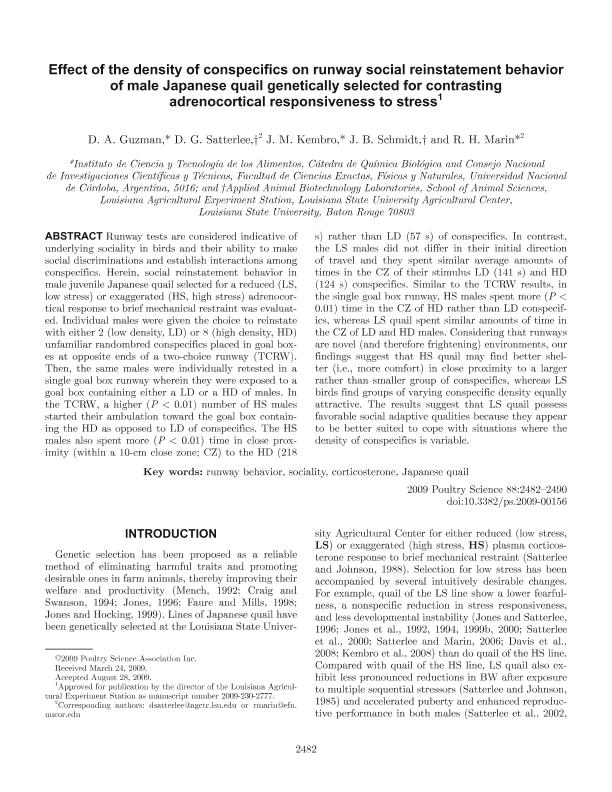Artículo
Effect of the density of conspecifics on runway social reinstatement behavior of male Japanese quail genetically selected for contrasting adrenocortical responsiveness to stress
Guzmán, Diego Alberto ; Satterlee, D. G.; Kembro, Jackelyn Melissa
; Satterlee, D. G.; Kembro, Jackelyn Melissa ; Schmidt, J. B.; Marin, Raul Hector
; Schmidt, J. B.; Marin, Raul Hector
 ; Satterlee, D. G.; Kembro, Jackelyn Melissa
; Satterlee, D. G.; Kembro, Jackelyn Melissa ; Schmidt, J. B.; Marin, Raul Hector
; Schmidt, J. B.; Marin, Raul Hector
Fecha de publicación:
01/12/2009
Editorial:
Oxford University Press
Revista:
Poultry Science
ISSN:
0032-5791
e-ISSN:
1525-3171
Idioma:
Inglés
Tipo de recurso:
Artículo publicado
Clasificación temática:
Resumen
Runway tests are considered indicative of underlying sociality in birds and their ability to make social discriminations and establish interactions among conspecifics. Herein, social reinstatement behavior in male juvenile Japanese quail selected for a reduced (LS, low stress) or exaggerated (HS, high stress) adrenocortical response to brief mechanical restraint was evaluated. Individual males were given the choice to reinstate with either 2 (low density, LD) or 8 (high density, HD) unfamiliar randombred conspecifics placed in goal boxes at opposite ends of a two-choice runway (TCRW). Then, the same males were individually retested in a single goal box runway wherein they were exposed to a goal box containing either a LD or a HD of males. In the TCRW, a higher (P < 0.01) number of HS males started their ambulation toward the goal box containing the HD as opposed to LD of conspecifics. The HS males also spent more (P < 0.01) time in close proximity (within a 10-cm close zone; Cz) to the HD (218 s) rather than LD (57 s) of conspecifics. In contrast, the LS males did not differ in their initial direction of travel and they spent similar average amounts of times in the Cz of their stimulus LD (141 s) and HD (124 s) conspecifics. Similar to the TCRW results, in the single goal box runway, HS males spent more (P < 0.01) time in the Cz of HD rather than LD conspecifics, whereas LS quail spent similar amounts of time in the Cz of LD and HD males. Considering that runways are novel (and therefore frightening) environments, our findings suggest that HS quail may find better shelter (i.e., more comfort) in close proximity to a larger rather than smaller group of conspecifics, whereas LS birds find groups of varying conspecific density equally attractive. The results suggest that LS quail possess favorable social adaptive qualities because they appear to be better suited to cope with situations where the density of conspecifics is variable.
Palabras clave:
Corticosterone
,
Japanese Quail
,
Runway Behavior
,
Sociality
Archivos asociados
Licencia
Identificadores
Colecciones
Articulos(CCT - CORDOBA)
Articulos de CTRO.CIENTIFICO TECNOL.CONICET - CORDOBA
Articulos de CTRO.CIENTIFICO TECNOL.CONICET - CORDOBA
Citación
Guzmán, Diego Alberto; Satterlee, D. G.; Kembro, Jackelyn Melissa; Schmidt, J. B.; Marin, Raul Hector; Effect of the density of conspecifics on runway social reinstatement behavior of male Japanese quail genetically selected for contrasting adrenocortical responsiveness to stress; Oxford University Press; Poultry Science; 88; 12; 1-12-2009; 2482-2490
Compartir
Altmétricas



